What Does Reclaim Waste Mean?
Wiki Article
Some Ideas on Reclaim Waste You Should Know
Table of ContentsThe 45-Second Trick For Reclaim WasteThe Ultimate Guide To Reclaim WasteNot known Details About Reclaim Waste The Ultimate Guide To Reclaim WasteThe 20-Second Trick For Reclaim Waste
Domestic sewage waste refers to the waste and items from a residential septic tank. The appropriate management and disposal of domestic sewage waste require fluid waste to be moved to a sewage treatment plant where the appropriate techniques and equipment are applied to cleanse and dispose of waste.
Industrial waste usually includes prospective dangers, such as combustible products or a combination of fluid and solid waste products, and calls for an extra sophisticated and detailed disposal process. The disposal of industrial waste normally entails the purification of waste prior to transportation to guarantee safe and correct disposal. Industrial waste is produced from by-products and runoff of commercial procedures and manufacturing.
This type of waste can not use the exact same sewage administration transport or processes as septic or business liquids. The commercial waste monitoring procedure calls for the examination and screening of liquid waste prior to it goes through the disposal procedure (liquid waste removal melbourne). Runoff waste is the liquid waste that comes from runoff and excess stormwater in very inhabited areas or cities
Runoff waste can cause contamination and flooding if not taken care of effectively. Making certain correct waste monitoring can protect against disasters and lower environmental harm.
Getting My Reclaim Waste To Work
Get in touch with PROS Providers today to learn more about our waste monitoring and disposal services and the proper means to take care of the liquid waste you produce.(https://disqus.com/by/reclaimwaste1/about/)Do you know what occurs to your water when you pull the plug, flush the bathroom or drain the washing device? No? Well, it deserves understanding. This supposed 'wastewater' is not just an essential source yet, after treatment, will be released to our land, waterways or the ocean. Utilized water from commodes, showers, bathrooms, kitchen area sinks, laundries and commercial processes is known as wastewater.

water utilized to cool machinery or tidy plant and tools). Stormwater, a kind of wastewater, is runoff that moves from farming and city locations such as roofing systems, parks, yards, roadways, paths and rain gutters into stormwater drains, after rainfall. Stormwater moves without treatment directly to local creeks or rivers, eventually reaching the ocean.
Getting My Reclaim Waste To Work
In Queensland, the majority of wastewater is dealt with at sewer therapy plants. Wastewater is transported from residential or industrial websites through a system of drains and pump stations, known as sewerage reticulation, to a sewage therapy plant. City governments develop, maintain and operate most sewer therapy plants. Operators are certified under the Environmental Management Act 1994 to release treated wastewater at an acceptable ecological standard right into waterways.The Division of Natural Resources recommends local governments concerning handling, operating and maintaining sewage systems and treatment plants. In unsewered locations, city governments might call for owners to mount specific or household sewage treatment systems to deal with domestic wastewater from toilets, kitchens, bathrooms and washings. The Division of Natural Resources authorizes the usage of family systems when they are shown to be efficient.
In some new class, therapy of some stormwater to remove litter, sand and gravel has begun using gross pollutant traps. Wastewater therapy takes place in four phases: Removes strong matter.
Wastewater then streams right into big storage tanks where solids settle and are eliminated as sludge. Grease and scum are skimmed from the surface. Utilizes tiny living microorganisms referred to as micro-organisms to break down and remove continuing to be liquified wastes and great bits. Micro-organisms and wastes are integrated in the sludge. Eliminates nitrogen and phosphorus nutrients that can cause algal blossoms in our waterways and intimidate aquatic life.
Not known Details About Reclaim Waste
Nutrient elimination is not available at all sewer therapy plants because it requires pricey specialised devices. Clear fluid effluent generated after therapy might still consist of disease-causing micro-organisms - liquid waste removal.
Most wastewater flows into the sewerage system. Under the Act, regional governments administer authorizations and permits for environmentally relevant activities (Periods) entailing wastewater launches that might have a local effect.
How Reclaim Waste can Save You Time, Stress, and Money.
Or else, web link samples are taken for research laboratory evaluation. Typically several examinations are needed to develop the levels of each of the different pollutants such as oils, heavy metals and chemicals in water. Monitoring offers valid details regarding water top quality and can verify that permit problems are being satisfied. The information gotten through surveillance supplies the basis for making water quality choices.Report this wiki page